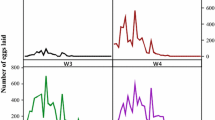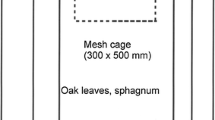Abstract
Nosomma monstrosum (Nuttall & Warburton) is a hard tick infesting mainly buffalo and cattle in Sri Lanka. Biological data on the life cycle pattern of N. monstrosum were collected using experimental infestation on New Zealand white rabbits under laboratory conditions. The three-host life cycle was completed within 64–102 days. Eggs hatched after 20–29 days of incubation and the larvae hatched out started feeding which lasted for 2–4 days. After a moulting period of 8–11 days nymphs emerge and they actively fed for 2–4 days. Subsequently the nymphs took 15–18 days for moulting before emerging as adults. Freshly moulted females fed for 7–8 days and remained latent for 4–5 days before starting the oviposition. Females laid 3864–12,520 eggs for 11–17 days. The male: female sex ratio was 8:3 in the adults which were moulted under laboratory conditions. Strong positive correlations were found in female weight with number of eggs laid and REI. Females raised from the first generation of eggs had higher oviposition periods, higher REI, laid ten times more eggs, and lower pre-oviposition periods compared to those collected from the wild. When a suitable host is given, N. monstrosum could successfully complete its three-host life cycle under laboratory conditions.


Similar content being viewed by others
References
Arthur DR, Chaudhri RP (1965) A revision of Nosomma monstrosum (Nuttall and Wrburton, 1908) Ixodoidea: Ixodidae. Parazitologia 55:391–400
Balashov YS (1972) Bloodsucking ticks (Ixodoidea)-vectors of diseases of man and animals. Misc Publ Entomol Soc Am 8:161–376
Benitez D, Cetrá B, Christensen MF (2012) Rhipicephalus (Boophilus) microplus ticks can complete their life cycle on the water buffalo (Bubalus bubalis). J Buffalo Sci 1:93–197
Bush AO (2001) Parasitism: the diversity and ecology of animal parasites. Cambridge University Press, Cambridge
Chen Z, Li Y, Liu Z, Yang J, Yin H (2012) The life cycle of Hyalomma rufipes (Acari: Ixodidae) under laboratory conditions. Exp Appl Acarol 56:85–92
Dipeolu OO, Amoo AO, Akinboade OA (1991) Studies on ticks on Veterinary importance in Nigeria: intrinsic factors influencing oviposition and egg-hatch of Amblyomma variegatum under natural conditions. Folia Parasitol 38:63–74
Estrada-Peña A, De La Fuente J (2015) The biology and ecology of ticks shape the potential for the transmission of zoonotic pathogens. Frontiers Research Topics, Frontiers Media, SA, New York
Gaxiola-Camacho S, García-Vázquez Z, Cruz-Vázquez C, Portillo-Loera J, Vázquez-Peláez C, Quintero-Martínez MT, Rosario-Cruz R (2009) Comparison of efficiency and reproductive aptitude indexes between a reference and field strains of the cattle tick Rhipicephalus (Boophilus) microplus, in Sinaloa, Mexico. Revista Brasileira de Parasitologia Veterinária 18:9–13
Geevarghese G, Mishra AC (2011) Haemaphysalis ticks of India. Elsevier, London, pp 86–103
Guglielmone AA, Robbins RG, Apanaskevich DA, Petney TN, Estrada-Peña A, Horak IG, Shao R, Barker SC (2010) The Argasidae, Ixodidae and Nuttalliellidae (Acari: Ixodida) of the world: a list of valid species names. Zootaxa 2528:1–28
Guglielmone AA, Robbins RG, Apanaskevich DA, Petney TN, Estrada-Peña A, Horak IG (2014) The hard ticks of the world. Springer, Dordrecht, p 738
Khan MH, Naithani RC, Singh KS (1982) Study on the bionomics of Nosomma monstrosum Nuttall and Warburton Acari: Ixodidae. Acarologia 23:119–123
Knight MM, Norval RA, Rechav Y (1978) The life cycle of the tick Hyalomma marginatum rufipes Koch (Acarina: Ixodidae) under laboratory conditions. J Parasitol 64:143–146
Kolonin GV (1995) Review of the ixodid tick fauna (Acari: Ixodidae) of Vietnam. J Med Entomol 32:276–282
Labruna MB, Fugisaki EYM, Pinter A, Duarte JMB, Szabó MJB (2003) Life cycle and host specificity of Amblyomma triste (Acari: Ixodidae) under laboratory conditions. Exp Appl Acarol 30:305–316
Liu J, Liu Z, Zhang Y, Yang X, Gao Z (2005) Biology of Dermacentor silvarum (Acari: Ixodidae) under laboratory conditions. Exp Appl Acarol 36:131–138
Liyanaarachchi D, Rajakaruna RS, Dikkumbura AW, Rajapakse RPVJ (2015) Ticks infesting wild and domestic animals and humans of Sri Lanka with new host records. Acta Trop 142:64–70
Nuttall GHF (1915) Observations on the biology of Ixodidae. Parasitology 7:408–456
Nuttall GHF, Warburton C (1908) On a new genus of the Ixodoidea together with a description of eleven new species of ticks. Proc Cambridge Philos Soc 14:392–416
Prakasan K, Ramani N (2007) Tick parasites of domestic animals of Kerala, South India. Asian J Animal Vet Adv 2:74–80
Prakasan K, Ramani N (2010) Studies on the life cycle of Nosomma monstrosum (Nuttall & Warburton) (Acarina: Ixodidae). Biosystematica 4:25–30
Sanches GS, Bechara GH, Garcia MV, Labruna MB, Szabó MPJ (1965) Biological aspects of Amblyomma brasiliense (Acari: Ixodidae) under laboratory conditions. Exp Appl Acaral 44:43–48
Schulze P (1919) Bestimmungstabelle ffir das Zeckengenus Hyalo’fnma Koch. Sitzungsb, Ges, Naturf, Freunde Berlin, Jahrg. pp 189–196
Seneviratna P (1965) The Ixodidea (Ticks) of Ceylon. Part 2 and 3. Ceylon Vet J 13:28–45
Sharif M (1928) A revision of the Indian Ixodidae with special reference to the collection in the Indian Museum. Rec Indian Mus 30:217–344
Singh KRP (1968) Description of the nymph and the larva of Nosomma monstrosum (Nuttall and Warburton, 1908). Parasitology 58:461–463
Siroky P, Erhart J, Petrzelcova KJ, Kamler M (2011) Life cycle of tortoise tick Hyalomma aegyptium under laboratory conditions. Exp Appl Acarol 54:277–284
Tanskul P, Stark HE, Inlao I (1984) A checklist of ticks of Thailand (Acari: Metastigmata: Ixodoidea). J Med Entomol 20:330–341
Warburton C (1918) Notes on ticks. Being descriptions of two new species of Ornithodorus and of the hitherto unknown female of Hyalomma monstrosum. Parasitology X, pp 284–287
Yano Y, Shiraishi S (1989) Feeding pattern, mating and oviposition in female Haemaphysalis longicornis Neumann (Atari: Ixodidae). J Fac Agric Kyushu Univ 33:287–296
Acknowledgments
The authors wish to thank Mr. P.H.G.J. Weerathunga for his contribution in tick collection. Financial assistance is given by National Research Council, Sri Lanka (Grant No. NRC 11-44).
Author information
Authors and Affiliations
Corresponding author
Rights and permissions
About this article
Cite this article
Bandaranayaka, K.O., Apanaskevich, D.A. & Rajakaruna, R.S. Life cycle of Nosomma monstrosum (Acari: Ixodidae) under laboratory conditions. Exp Appl Acarol 69, 97–106 (2016). https://doi.org/10.1007/s10493-015-0011-4
Received:
Accepted:
Published:
Issue Date:
DOI: https://doi.org/10.1007/s10493-015-0011-4




